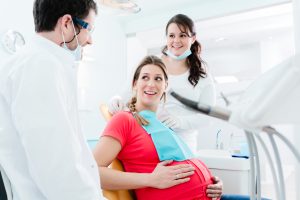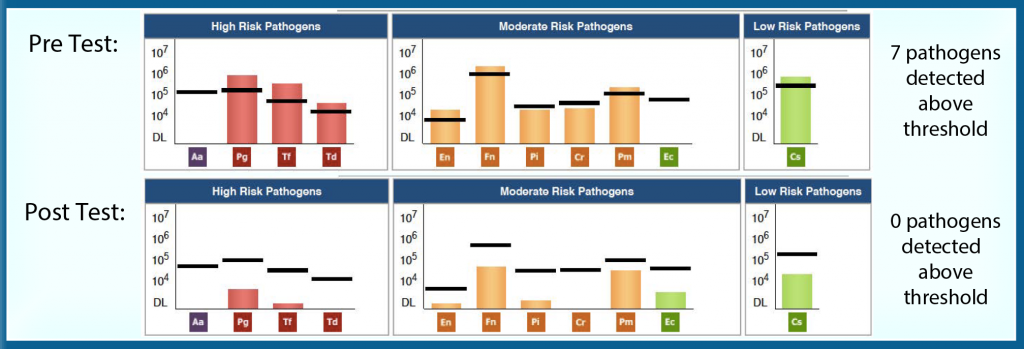
Background: Patient is a 31 year old female, who presented with the chief complaint “My gums are swollen and painful.” The last dental visit with exam was about 6 months ago. The radiographic examination including bitewings revealed horizontal bone loss and heavy amounts of generalized subgingival calculus. The patient’s gums were erythematous with probe depths between 5-9 mm. Patient was diagnosed with generalized severe chronic periodontal disease. The additional challenge was that the patient was trying to become pregnant. Multiple studies show the link between periodontal disease and low birth weight/ pre-term/stillborn babies. (1,2)
Challenge: Our goal was to treat the periodontal disease and reduce bacterial levels to lessen the impact of her periodontal disease to her potential pregnancy.
Solution: We recommended OralDNA® MyPerioPath® to personalize the treatment plan. The saliva specimen was secured on the initial exam date. Once the results from the MyPerioPath® were reviewed, we recommended 4 quadrants of scaling and root planing, including chlorhexidine irrigation, laser decontamination and use of systemic antibiotics to target the bacterial levels. After treatment, a post therapy saliva specimen was collected. The post MyPerioPath® (MyPerioProgress®) result was used to confirm the periodontal treatment positively impacted the patient’s bacterial loads/burden.
Result: The patient returned 3 months later for her first periodontal maintenance visit after scaling and root planing. Results from the initial saliva test showed 9 bacterial pathogens present with 7 pathogens above threshold level, including Fn bacteria associated with low birth weight and still born babies. After therapy and antibacterial services, a follow up MyPerioPath® (MyPerioProgress®) was performed to reveal the above threshold pathogens decreased from 7 to 0. The importance of this case and our protocol is that we were able to tell the patient with confidence that her periodontal disease was controlled, and that her now reduced bacterial levels will help to support her overall health too. This is an important test to do for any patient planning to become pregnant.*

References
1. Han YW, Houcken W, Loos BG, Schenkein HA, Tezal M. Periodontal disease, atherosclerosis, adverse pregnancy outcomes, and head-and-neck cancer. Adv DentRes 2014;26:47-55.
2. Andonova I, Iliev V, Zivkovic N, Susic E, Bego I, Kotevska V. Can oral anaerobic bacteria cause adverse pregnancy outcomes? Pril (Makedon Akad Nauk Umet Odd Med Nauki) 2015;36:137-43.
*Treatment protocols and results may vary
For more information on how to become an OralDNA Provider – scan HERE: 
- Case Study: Pregnancy and Periodontal Pathogens - December 1, 2017
